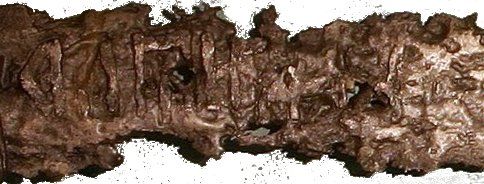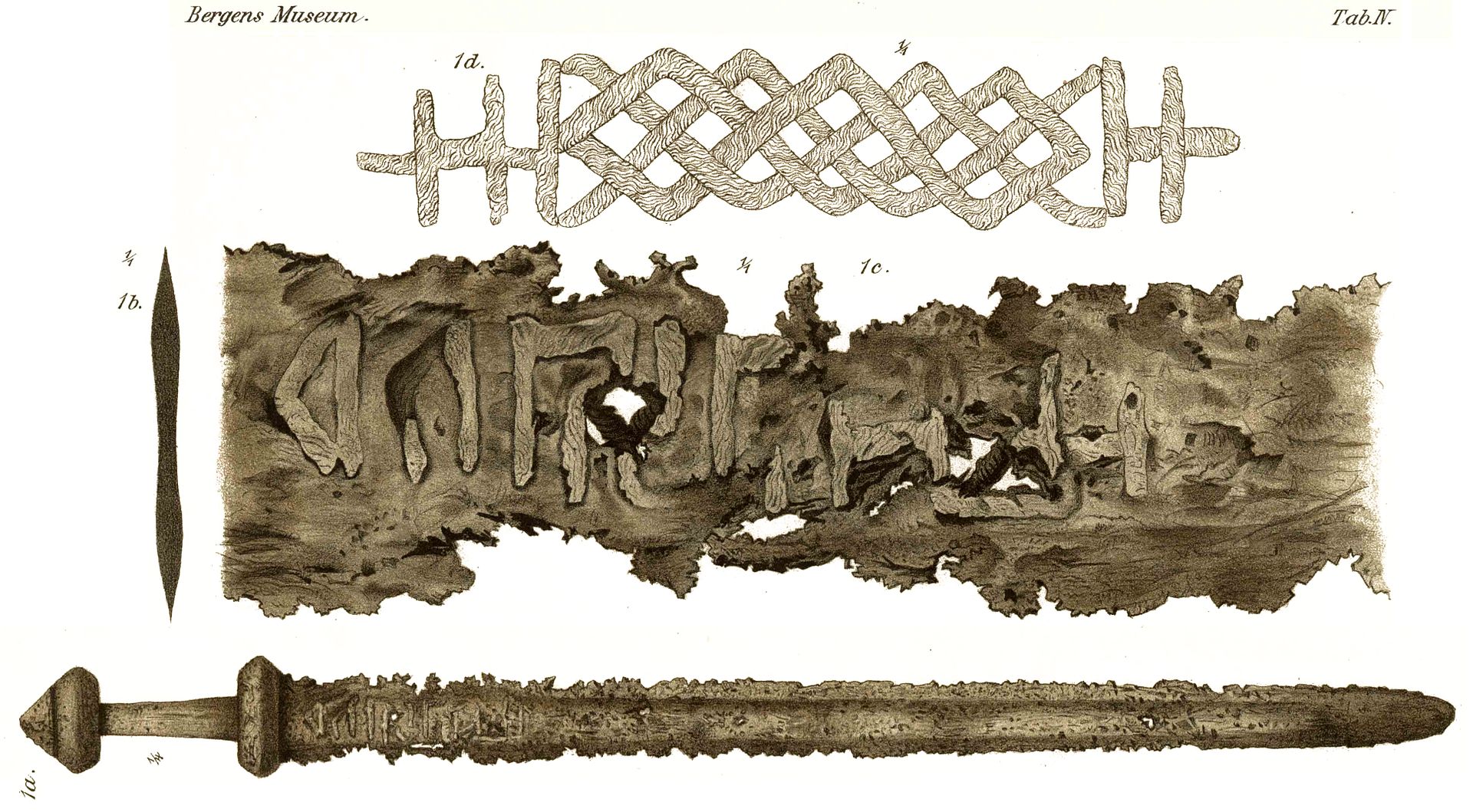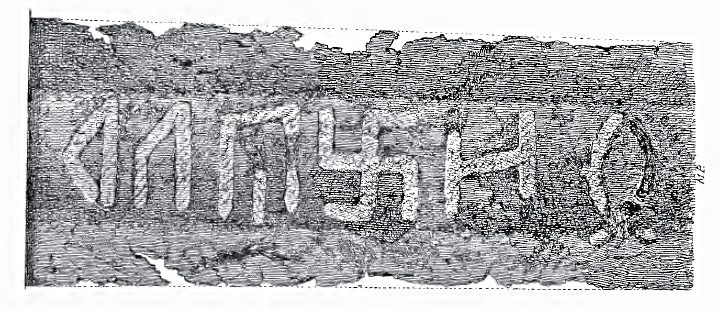The Sæbø Sword / The Saebo Sword
Aug 26, 2014 15:59:21 GMT
Post by Jack Loomes on Aug 26, 2014 15:59:21 GMT
Editor's Note: Please note that swastikas did not have negative connotations of racial hatred until they were adopted by the Nazi Party in the twentieth century, prior to that they stood for good luck as they continue to do in Asia to this day.

The Sæbø Sword as on display at Bergen Museum
The Sæbø sword (also known as the Thurmuth sword) is an early 9th-century Viking sword, found in a barrow at Sæbø, Vik, Sogn, Norway in 1825. It is now held at the Bergen Museum in Bergen, Norway. The sword has an enigmatic inscription on its blade, which has been identified as a runic inscription incorporating a swastika symbol. If so, this sword is a very rare example of a weapon with a runic inscription on its blade.

Remnants of the inscription as on display at Bergen Museum
The sword itself is categorized as 'Type C' by Pedersen (1919), who notes that it is unique in showing remnants of a metal thread at the broadsides of the upper hilt,[1] compared to other specimens of the type which show horizontal ridges or protruding edges, or less commonly inlaid forged stripes or protruding moldings that seem to be imitations of twisted or smooth thread. It is described as an imitation of a foreign [continental] sword inscription because of the lack of parallels in native tradition. There is an inscription realised in iron inlay along the center of the blade, close to the hilt.

Drawing from table IV in the book Den Yngre Jernalders Sværd by Anders Lorange, 1889
The sword was described in 1867 by George Stephens, an English archaeologist and philologist who specialised in the runic inscriptions of Scandinavia, in his book Handbook of the Old-Northern Runic Monuments of Scandinavia and England. In this work he showed a drawing of the sword with a very clear inscription comprising five runes or rune-like letters with a swastika symbol in the middle. According to Stephens the inscription reads oh卍muþ from right to left. He interpreted the swastika as being used in rebus-writing to represent the syllable þur for the god Thor, and thus expanded the reading to oh Þurmuþ meaning "Owns [me], Thurmuth". This reading was inspired by the idea that the swastika was used as a symbol of Thor (more precisely, of Thor's hammer) in Viking Age Norse paganism. It was the subject of scholarly discussion at the International Congress of Anthropology and Prehistoric Archæology at Budapest in 1876, where the prevalent opinion was that the swastika stood for "blessing" or "good luck".

Drawing of the inscription as published by Stephens
In 1889, in a review of a book by A. L. Lorange, Stephens noted that the sword had been treated with acid whilst at the Danish Museum, with the result that the sword and its inscription were severely damaged, and consequently the inscription shown in a colour plate in Lorange's book was undecipherable.

Drawing by George Stephens of the Sæbø sword and detail of inlaid decoration on the reverse
Material - Iron and steel, with iron inlays on blade.
Size - 95 cm total length (78 cm blade)
Created 800-850
Discovered - 1825; Sæbø, Vik, Sogn
Present location - Bergen Museum
Registration - Museum no. B1622
Source: en.wikipedia.org/wiki/S%C3%A6b%C3%B8_sword

The Sæbø Sword as on display at Bergen Museum
The Sæbø sword (also known as the Thurmuth sword) is an early 9th-century Viking sword, found in a barrow at Sæbø, Vik, Sogn, Norway in 1825. It is now held at the Bergen Museum in Bergen, Norway. The sword has an enigmatic inscription on its blade, which has been identified as a runic inscription incorporating a swastika symbol. If so, this sword is a very rare example of a weapon with a runic inscription on its blade.

Remnants of the inscription as on display at Bergen Museum
The sword itself is categorized as 'Type C' by Pedersen (1919), who notes that it is unique in showing remnants of a metal thread at the broadsides of the upper hilt,[1] compared to other specimens of the type which show horizontal ridges or protruding edges, or less commonly inlaid forged stripes or protruding moldings that seem to be imitations of twisted or smooth thread. It is described as an imitation of a foreign [continental] sword inscription because of the lack of parallels in native tradition. There is an inscription realised in iron inlay along the center of the blade, close to the hilt.

Drawing from table IV in the book Den Yngre Jernalders Sværd by Anders Lorange, 1889
The sword was described in 1867 by George Stephens, an English archaeologist and philologist who specialised in the runic inscriptions of Scandinavia, in his book Handbook of the Old-Northern Runic Monuments of Scandinavia and England. In this work he showed a drawing of the sword with a very clear inscription comprising five runes or rune-like letters with a swastika symbol in the middle. According to Stephens the inscription reads oh卍muþ from right to left. He interpreted the swastika as being used in rebus-writing to represent the syllable þur for the god Thor, and thus expanded the reading to oh Þurmuþ meaning "Owns [me], Thurmuth". This reading was inspired by the idea that the swastika was used as a symbol of Thor (more precisely, of Thor's hammer) in Viking Age Norse paganism. It was the subject of scholarly discussion at the International Congress of Anthropology and Prehistoric Archæology at Budapest in 1876, where the prevalent opinion was that the swastika stood for "blessing" or "good luck".

Drawing of the inscription as published by Stephens
In 1889, in a review of a book by A. L. Lorange, Stephens noted that the sword had been treated with acid whilst at the Danish Museum, with the result that the sword and its inscription were severely damaged, and consequently the inscription shown in a colour plate in Lorange's book was undecipherable.

Drawing by George Stephens of the Sæbø sword and detail of inlaid decoration on the reverse
Material - Iron and steel, with iron inlays on blade.
Size - 95 cm total length (78 cm blade)
Created 800-850
Discovered - 1825; Sæbø, Vik, Sogn
Present location - Bergen Museum
Registration - Museum no. B1622
Source: en.wikipedia.org/wiki/S%C3%A6b%C3%B8_sword

.png?width=1920&height=1080&fit=bounds)